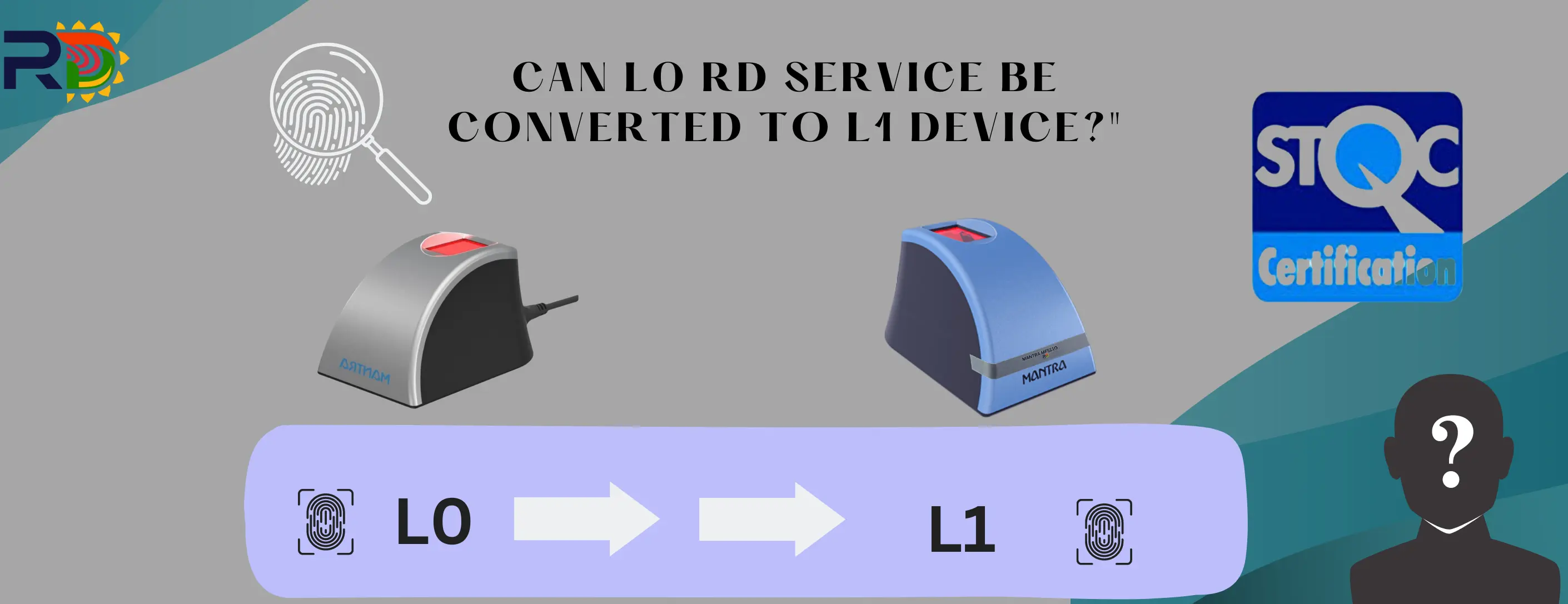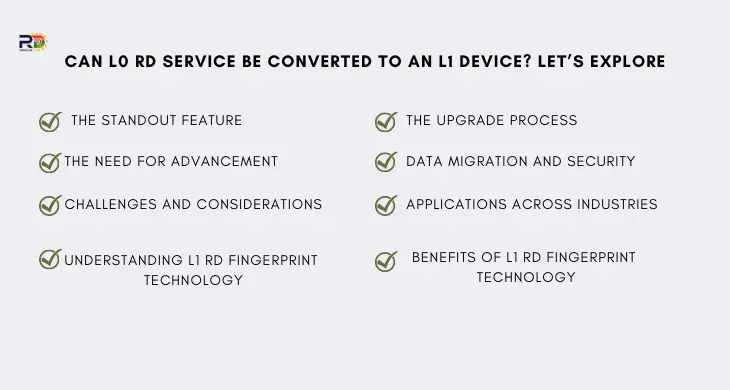
Can L0 RD Service be Converted to an L1 Device? Let’s Explore
As the landscape of biometric security continues to evolve, the transition from Level 0 (L0) to Level 1 (L1) RD Fingerprint Technology is a major step forward. A new chapter is being revealed in the world of advanced authentication with this transition, which represents a transformative journey in fingerprint scanning. In this blog, we explore intricacies of this evolutionary path, exploring the profound impact of L1 RD Fingerprint Technology on the expansive canvas of biometric security.
**Introduction:**
Biometric technology has revolutionized the way we authenticate and secure sensitive information. From fingerprints to facial recognition, these technologies have become integral to various sectors, including finance, healthcare, and government services. Among these biometric fingerprint device, fingerprint authentication remains one of the most widely used and trusted methods.
**The Need for Advancement:**
While Level 0 Biometric technology served its purpose for a time, the ever-increasing demand for enhanced security and efficiency necessitated a shift towards more advanced solutions. Recognizing this need, authorities like the Unique Identification Authority of India (UIDAI) have spear the headed the transition from L0 to L1 RD Fingerprint Technology.
**Understanding L1 RD Fingerprint Technology:**
At the heart of L1 RD Fingerprint Technology lies the utilization of ridge distance measurements, a sophisticated approach that ensures more accurate and secure fingerprint matching. Unlike its predecessor, L1 technology leverages all the capacitive sensors known for their superior performancealso resulting in faster and more reliable biometric readings.
**Benefits of L1 RD Fingerprint Technology:**
The benefits of upgrading to L1 RD Fingerprint Technology are manifold. Firstly, it promises a significant reduction in rejection rates compared to older L0 Optical sensors, enhancing user experience and reducing authentication errors. Additionally, L1 authentication is seamlessly integrated into end-user devices, making it ideal for high-throughput content services such as banking and smart card management.
**Applications Across Industries:**
The versatility of L1 RD Fingerprint Technology extends across various industries, ranging from finance to healthcare. In banking, it facilitates secure access to sensitive financial information, while in healthcare, it ensures accurate patient identification and record management. Moreover, L1 technology holds promise in government services, where it can streamline processes like eKYC and attendance tracking.
**The Standout Feature:**
Among the standout features of L1 fingerprint readers is their unparalleled autonomy. Unlike other biometric devices that rely on software and hardware dependencies, L1 readers operate independently, eliminating the need for specific software driver support. This inherent self-sufficiency not only enhances device reliability but also contributes to elevated security standards.
**The Upgrade Process:**
Upgrading to L1 RD Fingerprint Technology involves a series of meticulous steps aimed at ensuring a smooth transition. It begins with a comprehensive assessment of the existing Level 0 system, followed by familiarization with L1 principles and features. Hardware and software requirements are then determined, and integration plans are developed in collaboration with relevant stakeholders.
**Data Migration and Security:**
One of the critical aspects of the upgrade process is data migration and security. Prioritizing the security of existing fingerprint data, organizations must create comprehensive backups and develop robust data migration strategies to transition user profiles seamlessly. Validation checks are performed to ensure the accuracy and integrity of the migrated data, safeguarding against potential vulnerabilities.
**Challenges and Considerations:**
While the transition to L1 RD Fingerprint Technology offers numerous benefits, it is not without its challenges. Organizations must navigate hardware compatibility issues, ensure seamless integration with existing software infrastructure, and address any resistance to change among stakeholders. However, with careful planning and collaboration, these challenges can be overcome, paving the way for a more secure and efficient authentication ecosystem.
Certainly! When discussing the transition from Level 0 (L0) to Level 1 (L1) RD Fingerprint Technology, it's important to consider the implications of RD (Ridge Distance) activation on devices. Once RD is activated on an L0 device, it's essential to understand that this activation cannot be transferred or converted to an L1 device. This limitation arises from the fundamental differences in hardware between L0 and L1 devices.
The activation of RD on an L0 device is specific to its hardware configuration and is not transferrable to an L1 device due to the distinct characteristics and functionalities of each device type. Essentially, the RD activation is tied to the hardware components of the L0 device and cannot be seamlessly migrated to an L1 device.
This distinction underscores the importance of strategic decision-making when implementing biometric authentication solutions. Organizations must carefully evaluate their requirements and choose the appropriate level of technology accordingly. Once RD is applied to an L0 device, it becomes essential to recognize that any transition to L1 technology would necessitate the acquisition of new hardware specifically designed for L1 capabilities.
In summary, while the advancement to L1 RD Fingerprint Technology offers significant benefits in terms of performance and security, it's crucial to consider the limitations associated with RD activation on L0 devices. Planning for future transitions and technology upgrades requires careful consideration of hardware compatibility and the unique features of each device type.
**Conclusion:**
In conclusion, the transition from Level 0 to Level 1 RD Fingerprint Technology represents a significant milestone in the evolution of biometric security. With its advanced features, seamless integration, and unparalleled autonomy, L1 technology promises to revolutionize authentication across industries, setting new standards for accuracy, reliability, and security. As organizations embrace this transformative journey, they embark on a path towards a more secure and efficient future in the realm of biometric authentication.
Frequently Asked Questions
What is the Registered Device Management (RDM) Platform?
The RDM Platform is a scalable, fully managed SaaS-based IoT platform designed to support both L0 and L1 compliant devices for critical national identity management platforms like Aadhaar and MOSIP.
What features does the RDM Platform offer?
The platform offers a range of features including administration portal, secure API integrations, device key management, telemetry data monitoring, device application change management, device SDK support, APIs for device registration, robust firmware security, chip provisioning, seamless upgrades, and chip mastering services.
How does the RDM Platform simplify device management?
It facilitates faster registration and deregistration of devices, software upgrades, key rotation, and compliance with UIDAI guidelines, all through a customizable role-based administration portal.
How does the RDM Platform ensure security?
The platform employs a range of security measures including secure signing, encryption, and maintenance of firmware for L1 devices, compliance with FIPS 140-2 Level 3 standard, and regular security audits.
What support does the RDM Platform offer for device manufacturers?
It provides chip provisioning services for L1 devices such as chip identity generation, firmware personalization, and secure firmware download for chip manufacturers.
Can the RDM Platform be integrated with different operating systems?
Yes, the platform supports multiple platforms including Linux, Windows, and Android, with technical support provided to ensure seamless integration.
How does the RDM Platform handle device onboarding?
Devices can be onboarded using various methods including one-time token, device whitelisting, and whitelisting from the manufacturer, with options to map devices to specific customers for telemetry purposes.
Is technical support available for users of the RDM Platform?
Yes, the platform offers customized technical support throughout the integration process and beyond, with portal and email-based support driven by SLAs.
What is the track record of the RDM Platform?
How can I get started with the RDM Platform?
Simply engage with us to discuss your needs and requirements, and our team will provide the right solution to help you stay protected and fulfill your security goals.
